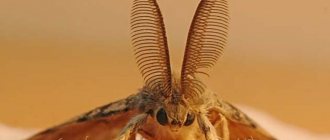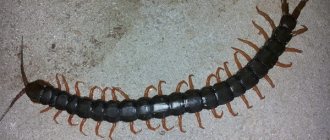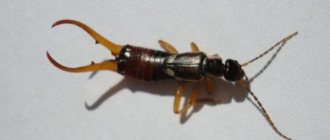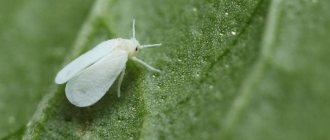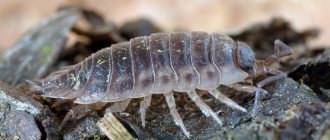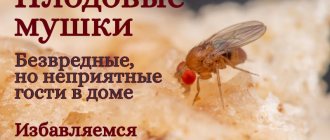When a flour bug appears in the house, this means that, most likely, basic measures for storing bulk products were not followed. If measures are not taken in a timely manner, the insect will multiply so much that it will be very difficult to cope with it on your own.
To understand how to act if a room is infested with a flour pest, you need to know what it is, where it hides, what it eats, and most importantly, what it is vulnerable to.
Keeping in captivity.
The mealworm is bred as a food insect.
Beetles and larvae are fed to birds, some mammals, fish, predatory insects, reptiles and amphibians. It should be noted that, due to its hard integument, the mealworm is not suitable as food for all reptiles and amphibians. The mealworm contains about 53% protein, 33% fat, 6% carbohydrates, 0.11% calcium and 0.77% phosphorus.
In some countries, mealworm larvae are also eaten by people, mainly fried.
A container with flour beetles - paper folded like an accordion lies on top of the ground - a shelter for pupae.
However, the mealworm can be interesting in itself, as an unpretentious inhabitant of the insectarium, where you can easily trace all stages of the development of the insect with complete transformation... The entire development cycle of the mealworm, from egg to adult, under favorable conditions, can be 2-3 months . At a temperature of 25-27°C, the larvae emerge from the eggs in about a week. Having shed about 8 times, the larva turns into a pupa in 1.5-2 months. The pupal stage at the indicated temperature will last approximately another week. Within a month after emerging from the pupa, the beetle becomes sexually mature. The female lays eggs about a week after mating.
An insectarium option for flour beetles.
Plastic containers or glass aquariums can be used as containers for keeping flour beetles. The top of the aquarium is covered with a mesh lid. The mesh should occupy the entire area of the lid (to avoid increasing humidity inside the insectarium). It is best to use a metal mesh so that beetles cannot chew through it. Beetles have wings and are able to fly (although they do this extremely rarely), in addition, they can quite dexterously climb, say, along the seam of an aquarium or on dirty glass - so a lid is necessary... A layer (preferably no more than 10 cm) consisting of a filler capable of absorbing is poured into the container moisture, for example - sawdust (not resinous), wood filler for rodents or feed pellets and any grain mixture (rye, wheat, millet, oats, rice...). This soil will be both a habitat for insects and their main food. Place crumpled or accordion-folded paper in several layers on top - the larvae will pupate in it, as well as plywood or cardboard on which succulent food can be placed (so that it does not wet the soil). In principle, flour beetles can do without succulent food completely. In a large container with a grain mixture, a colony of beetles can exist without feeding for years. However, the larvae develop faster, and adult beetles live longer if they receive succulent food and, accordingly, lay more eggs during their lives... In addition, if the mealworm is bred for food, then it must be fed with vegetables, fruits, calcium-containing additives and protein food so that its composition , as food, was more complete... So much succulent food must be given so that the beetles eat it completely in a few hours, otherwise the grain mixture-soil will begin to become damp, flour mites may appear in it, and all this can completely destroy the flour beetle population. From succulent plant foods, beetles can be given: dandelion leaves, lettuce, carrots, apples, cabbage and other vegetables and fruits. As a protein and calcium supplement, you can periodically feed insects minced chicken breast and crushed eggshells. Over time, flour beetles pollute and eat away the nutrient soil into dust, so periodically it needs to be renewed partially or completely...
Mealworm pupae - white on the left - recently pupated; on the right, darkened before turning into an adult.
How to get rid of an insect?
First of all, you need to store food correctly, this reduces the likelihood that it will be damaged by pests, and not just weevils.
Methods for controlling beetles in products
It is necessary to review supplies more often in order to identify bugs in time, keep the table and pantry clean, and wipe the shelves with soapy water and vinegar solution. If pests are found, and while there are still few of them, you can sift the cereals and grain; if this is not enough, you will have to fight with insecticides.
Food storage rules
The room where the food is stored should not be humid or too warm. They should be stored away from light in a cool place.
Fighting weevils on indoor plants
Flowers on windowsills can also suffer from the pest. Bugs gnaw through buds and leaf buds, causing them to wither and not bloom. All affected shoots should be cut off and thrown away, the rest should be treated with insecticides Inta-Vir, Fufanon or similar, or the entire flower should be sprayed with mustard infusion (30 g of powder per 1 liter).
Professional processing
When there is a large concentration of insects, it is not always possible to destroy pests on your own. In such situations, it is necessary to seek help from special pest control services, whose experienced specialists have experience in dealing with household pests. It is contraindicated for children and pets to be in the room during this treatment. It would also be a good idea to take out food, indoor plants, children's clothes and toys.
Regular cleaning and proper storage of food are the most reliable and effective means of protecting food. By following these simple rules, you won’t have to fight the mealy bug. Well, if you happen to identify pests in a particular product, you should not hesitate or panic - you need to start fighting them as quickly as possible.
How do insects get into cereals?
Most often, beetles appear in an apartment already with cereals. When you buy low-quality cereal, either loose or already packaged, insects or their eggs may already be there. If you buy cheap cereals from unreliable manufacturers, the risk of infection becomes much higher. To be sure that pests will not appear in your kitchen, it is better to give preference to well-known brands that value their reputation. Such products undergo repeated testing, and the conditions of their production exclude contamination.
Insects can also enter the kitchen along with dried fruits. If you buy them by weight at stalls or markets, you may receive a product with an additional weight in the form of bugs. They are especially common in goods from Kyrgyzstan and Uzbekistan. The same applies to spices and other bulk goods offered by weight.
Chemicals
Among the chemicals used in apartments, pyrethroid chemicals are most often used:
- pirimophos,
- bifenthrin and other drugs.
These are tablets, solutions, gels and aerosols that are bought in the hardware department of stores.
When there are a lot of Khrushchak insects, there is no desire to fight them or it takes little time to destroy them, they invite specialist exterminators. Professionals spray the chemical using modern special equipment. Fine dust is created that penetrates everywhere.
Types of pests
The following types of household pests are known today:
Bread grinder
It is found in bakeries, where they forget about basic hygiene and disinfection methods and, perfectly adapting to almost any environment, ends up with the products in homes. The size of the insect is 3 millimeters in length, it flies perfectly, which allows it to quickly move from place to place and, because of this, it is more difficult to eliminate. Usually he eats bread, but he can also enjoy rice, buckwheat, tea, animal food and even an old book.
Mucoed
Prefers flour, cereals and grains. It is very voracious, despite its tiny size - 2 millimeters in length. The flour beetle larva is even smaller, so it is difficult to notice it right away: black dots found in flour are a sign of the presence of mucoed larvae in it. The beetle is very prolific, producing offspring up to 7 times a year in large quantities. Therefore, in just a couple of months, flour can turn into a breeding ground for these insects. The ideal environment for mucoed is high humidity and warmth.
Flour beetle
This is a small insect up to 4 millimeters long, reddish-brown in color. It multiplies rapidly, and settles not only in flour and cereals, but also in furniture and dishes. Breeding a beetle is very difficult, as it is unpretentious to living conditions and is hardy.
food moth
She looks like a simple moth. The length of its body does not exceed 1 centimeter. It is characterized by high fertility (over five hundred eggs in two weeks, from which caterpillars hatch). The moth devours cereal reserves at high speed. Her ability to hide, fly and disguise herself as dark objects makes her virtually invulnerable.
Weevils
They can appear in literally all products: cereals, flour, bread, dried fruits, fruits and vegetables. They look like small bugs, about 5 millimeters in size with a long proboscis. Weevils can fly, changing their location depending on changes in environmental conditions, and also easily climb walls. The pest produces offspring up to 6 times a year. They settle everywhere: remote corners of the kitchen cabinet, containers of cereals, bed linen, baseboards, cracks.
Biology
Description
The flour beetle, as this insect is also called, grows up to 18 millimeters in length. Its flat body has a brown-black, slightly shiny chitinous cover on top.
If we turn the insect over, we will see the brown abdomen of the beetle.
Spreading
The large flour beetle, and there is also a small one, but more about that later, is native to the Mediterranean, but has now spread throughout the world. The main places of its distribution are flour warehouses, grain barns and bakeries. But he can also live perfectly in your apartment.
In nature, the insect appears in mid-summer. At this time, its natural reproduction occurs, and the mealworm flies a lot from place to place. He especially likes to move in the direction of light or fire in the evenings.
Nutrition
Contrary to its name, the mealworm eats almost everything it comes across. His diet may include:
- cereal grains;
- pasta;
- raisin;
- dried fruits;
- dry corpses of dead animals and birds;
- bird feathers;
- wool;
- fabrics;
- starch;
- vegetable and fruit seeds.
To summarize this list, let's just say that the pest practically does not die from hunger.
Lifehack
The main way to prevent insects from outside from approaching bulk products is through sealed storage containers. They are not always at hand, but you can quickly organize safe conditions for storing cereals directly in a factory bag. To do this, you will need a neck with a cap cut off from a plastic bottle.
The opened corner of the bag (provided that the rest of the bag is intact) is pulled through the neck and the edges of the bag are folded outward. A cork is screwed onto the neck over the cellophane - the express container is ready. Of course, it won’t save you from voracious larvae, but adult beetles won’t crawl in. Less temptation means fewer pests.
Bugs in flour and cereals are an extremely unpleasant phenomenon, but they can appear in almost any kitchen. This is not evidence that the housewife does not keep an eye on the food in the cupboard, because cereals are often stored for a short period of time. Small pests enter the house from store shelves, from warehouses where large quantities of cereals, flour, dried fruits or nuts are stored.
Such bugs pose no danger to humans, but the same cannot be said about the family budget. The value of contaminated products is reduced to almost zero, since insects eat the nutritious core of the grains.
How dangerous is it for humans?
The flour beetle eats almost everything. They don’t mind eating flour products, bran, other semi-finished products, etc. If they have no access to bulk foods, they can switch to other products, such as chocolate, nuts, dried fruits, glue, cardboard, knitwear, etc. . Food products that have been attacked by these pests are not suitable for further consumption.
Beetles and their larvae can be removed mechanically without any problems, but their eggs are much more difficult to remove due to their very small size. In addition, they are firmly held on any surface. While in food, pests leave behind waste from their vital activity: especially noteworthy is the special smell that cannot be gotten rid of.
There is evidence that the beetle larva can easily chew through burlap or tarpaulin. They can also handle bed linen, as well as other things made from natural ingredients. In addition, beetles can also harm pets. Since flour-eating beetles multiply quite quickly, you should not hesitate to destroy them.
On a note! Contaminated food should not be consumed as it has a certain level of toxicity. Various complications may develop, such as allergic reactions. Serious food poisoning is also possible.
Photos and names of black beetles
You can determine exactly what the black beetle in the house is called by its appearance and size, as well as its location. They can settle both in food and in furniture, carpets or wooden structures and walls.
The most common black beetles, which sometimes settle in an apartment or private house, are beetles or flour beetles. They received their second name because they prefer to eat cereals and other bulk products.
In total, there are 3 types of Khrushchak:
- large beetles - differ in their length (up to 13 mm);
- small – have a size of up to 3.6 mm;
- black - distinguished by black color.
Black bugs in the apartment
In addition to the flour beetle, there are other types of small black bugs in the apartment:
- skin beetles - small black insects up to 4 mm in size that feed on fur and leather products, paper from books, indoor plants and food (flour, nuts, cereals, meat, etc.) - live in closets, old clothes, crevices of furniture; dangerous because they can carry infections and helminths;
- carpet beetles - they settle in beds and carpets, feeding on old peeling human skin, hair and crumbs; they can render things unusable and also cause allergies in some people;
- fleas are small jumping parasites that bite painfully and can carry infection; they often appear in homes where cats and dogs live.
Hazard to human health
Let's find out why insects in cereals are dangerous and how they can affect your health. Small black bugs in the kitchen do not pose a threat in themselves. The problem is a large number of eggs and voracious larvae, which reduce the nutritional value of the affected product. Their waste products may contain antigens to which the body will react by developing an allergy.
The most dangerous pests in this regard are flour and semolina, since their excrement is often indistinguishable from particles of these products and can provoke an allergy attack and exacerbation of asthmatic symptoms.
If there is a mucoid infection, then there is a high probability that mold will also get into the food (remember that mucoeds love high humidity). Cereals and flour with such pests can lead to poisoning or intoxication of the body, especially with prolonged consumption of spoiled groceries.
Habitats and ways of entering the apartment
This pest species is common in all regions of the country. In addition, it is found in the CIS countries. Flour beetles can live in the natural environment and in human dwellings, various buildings (barns, granaries and factories for the production of certain types of products). It is not difficult for these pests to penetrate a box, bag, or package, since their mouthparts easily gnaw through plastic, paper and woven material.
Flour bugs can penetrate into any crack, climb under the wallpaper, and reproduce here. The insect hides its offspring on any surface. This is possible thanks to the sticky substance that covers the egg shells. Suitable habitats for the beetle are a kitchen drawer or a pantry where supplies are stored. Bugs can hide under baseboards.
The most effective method to eliminate pests completely is to throw away all contaminated products.
The larger the colony size, the more impudently the pests behave. Gradually, the Khrushchaks begin to feel like masters of their home and move around without hiding. Favorite food is damp, musty bulk products. The large Khrushchak loves a humid environment, while a dry and warm microclimate is suitable for its small counterparts. For this reason, small bugs have become more widespread.
Ways to enter the apartment:
- Lesser hruschak is already contained in purchased products. This means that the infection occurred in the warehouse, which was facilitated by improper storage conditions or violations of production specifications.
- The large beetleworm enters houses through ventilation shafts.
Ways to fight on your own
If, due to various circumstances, it is not possible to mercilessly throw away food, you can use the following methods:
- roast the cereals in the oven at maximum power;
- freeze food products by leaving them in the freezer for at least a day.
However, this option for pest control is not suitable for all products, since, for example, flour will lose its properties after being treated at different temperatures.
First, collect and dispose of all dried fruits, cereals, pasta and other bulk products that are available in the house. Second, thoroughly ventilate and wash cabinets, drawers, and shelves in the kitchen and pantry. For disinfection, you should use a solution of vinegar or soda; all food pests are afraid of these components.
Thirdly, treat the floors in the room with strong chemicals, paying special attention to the baseboards, since it is under them that beetles often accumulate. Fourth, to store new products, purchase tightly screwed jars or other airtight containers
Vacuum bags with Velcro or other fasteners are popular, however, as practice shows, the flour beetle penetrates into such containers without problems. Fifth, after cleaning the cabinets, treat the walls, floor, window sill, all drawers and cabinet joints with store-bought anti-flour beetle solutions or pastes, if possible, leave the room for several hours, then rinse all treated areas again with vinegar essence.
It may seem that the process of pest control is quite complicated, but lesser measures will not lead to the desired result, because the egg clutches of the flour beetle can be located in a variety of places, it is better to protect yourself from the appearance of such unpleasant neighbors.
If there are small parasites in the kitchen, it will be difficult to completely get rid of them. It is much easier to prevent their appearance. To do this, you need to regularly inspect the shelves and products, thoroughly clean and wash the shelves, as well as the room itself where food products are stored.
It doesn’t matter whether large or small beetles appear on the grocery shelves, the methods of dealing with them will be the same. It should be remembered that pests like wet, stale foods.
Therefore, moisture should not be allowed to appear in cabinets. It is also advisable not to buy too many cereals if there are no containers to properly store them.
After the contents of the container have been used, you should not immediately add a new portion of food. The jar or plastic container must be thoroughly washed and dried. This is done in order to destroy the eggs of the beetle, if they are there.
Another interesting way is to place a piece of metal wire, metal caps (for example, from a bottle) or nails on the cabinet shelves
It is important to remember that metal products can rust, so they should not be wet, but only wiped with a dry towel
If the appearance of flour beetles cannot be avoided, the food will most likely have to be thrown away. The dishes in which the food was stored, as well as the room itself and the furniture should be washed with a bleach solution.
Of course, you can sort out the grains and sift the flour. But there is no guarantee that there will be no skins left from molting bugs or eggs among the products. Since beetles reproduce quickly, all the work can go down the drain. Therefore, it is best to throw away contaminated cereals or feed them to birds.
Therefore, it is necessary to disinfect the entire room:
- Bulk products must be thrown away. This also applies to dried fruits and legumes.
- All cabinets and surfaces should be thoroughly cleaned with a vinegar solution.
- The floor and baseboards should also be disinfected, because beetles can appear there too.
- The walls and ceiling also need to be treated.
- The entire washing procedure must be repeated after a few hours.
It should be remembered that if not a single beetle is visible throughout the room, this does not mean that it is completely destroyed. There is a possibility that egg clutches will remain invisible due to their small size. To prevent the whole nightmare from repeating itself after a couple of weeks, cleaning with disinfectants must be thorough and repeated.
Tribolium confusum Duv.
|
You can encounter the small flour beetle much more often than the large one. Of course, we do not mean possible encounters with them in pet stores or at bird markets. Beetles and small mealworm larvae can accumulate in products during long-term open storage. If at least one beetle or one larva is found in a bag of flour or pasta, we can assume that it is no longer your food supply, but his. In this case, it is almost impossible to get rid of the pest. Even sifting does not help, since the beetle eggs are so small that they pass through the tiny holes of the sieve. And in appearance they are practically indistinguishable from grocery bags. That’s why this beetle is sometimes also called the deceiver Khrushchak.
Spreading
This beetle is synanthropic and cosmopolitan.
External signs
The beetles themselves are small, 3–4 mm in size, with an elongated, bare, slightly shiny red-brown body and parallel elytra.
Lifestyle
Their lifestyle resembles that of their “big brother”. Distributed everywhere in the same places as the large beetle, although it is less common in granaries and more often in houses. Beetles and larvae damage rye, wheat and rice flour, bran, semolina, and rolled oats. They eat buckwheat, rice, and dry fruits less often. Due to their small size, they penetrate into loosely closed boxes or display cases with zoological exhibits and often damage them.
Small mealworm larva
The female's fertility is up to five thousand eggs. They put them in cracks, flour dust, on sacks of flour, bran and grain.
Role in nature
Scientists have discovered an interesting pattern: the fecundity of the small beetle at 27°C is lower than at 34°C, but in the first case, larvae hatch from all eggs, and in the second, from only 75%. Typically, larvae hatch from laid eggs on the 6th–7th day. Products colonized by them acquire an unpleasant odor, flour forms lumps and becomes unsuitable for baking bread. The entire development from the egg to the emergence of the beetles in a heated room takes about a month. Several generations develop over the course of a year.
Control measures
The most common and effective method of combating both beetles is gas fumigation of long-term stored products, warehouses, and grain tank holds.
Such processing should be carried out with all necessary precautions.
However, you can get rid of the small mealworm in a simpler way - by cooling the substrate where it was found. Insects die when exposed to temperatures below 7°C for several weeks.
Methods for preventing the appearance of bugs in the kitchen
- The best prevention is timely cleaning of the kitchen and checking cereals.
- It is advisable to seal all cracks in furniture and floors.
- Bulk products should be stored in closed containers (transparent plastic and glass will allow you to detect the enemy in time).
- This is also true for sweets.
- You should not store a lot of cereals in one place and purchase large volumes at once.
- When buying bulk products in transparent packaging, carefully examine them in the store.
- Place newly purchased products in the freezer for a day or in the oven for 15 - 20 minutes.
- Dried fruits, nuts and legumes can be stored in the refrigerator.
- Ventilate the kitchen and cabinets themselves more often. High humidity attracts unwanted residents.
May you only have welcome guests. See you again in Your home!
As with most problems, it is easier to prevent bugs from appearing in the kitchen than to try to remove them later. We have put together a selection of recommendations for you that will repel parasites from your kitchen and help keep your food safe.
https://www.youtube.com/watch?v=NzJAWDvm5Zw
Do not leave cereals and groceries in their original packaging. This is not very convenient, and it also encourages the appearance of bugs and other parasites. And the safety of cereals leaves much to be desired: they deteriorate much faster in polyethylene.
The bugs will have no chance of getting into the container.
The desire to stock up is a good thing. However, should they all be stored in the kitchen? For most grains, the best place to store them is the refrigerator or even the freezer.
Bugs cannot tolerate low temperatures.
Low temperatures will not give the bugs the slightest chance to reproduce, and will not spoil the taste of the food.
Place the selected ingredient in fabric bags and place it on the shelves between containers with bulk products.
It is not at all necessary to pour it into food: we doubt that this will make rice or oatmeal tastier. But once a week, wiping the shelves with a weak vinegar solution won’t hurt: this way you will remove the eggs and larvae of bugs, preventing them from multiplying.
Vinegar will remove bugs, larvae, and eggs.
Do you want to avoid parasites? Place cardamom or anise seeds, cloves of garlic or nutmeg on the shelves, and place a couple of sprigs of pine needles or wormwood. We recommend, however, not to choose too strong aromas and adhere to the principle of moderation. Otherwise, along with the bugs, the household will disappear from the house.
Scent bomb to fight bugs.
Bugs can take a liking to the kitchen for various reasons, which do not always depend on the housewife’s neatness, namely:
- violation of storage conditions and expiration dates of food products;
- bulk products purchased by weight;
- poor-quality grain processing in production;
- failure to comply with sanitary standards for storing and packaging goods at enterprises;
- increased humidity levels in food storage areas.
You can't trust packaged cereals unconditionally.
Sealed packaging of products is not a guarantee that there are no bugs in the contents - they can get inside directly from factories and enterprises.
A few simple rules will help eliminate the possibility of “undesirable neighbors” appearing on your territory:
- when purchasing bulk products, you must carefully inspect the packaging for leaks and the presence of parasites inside;
- Before placing it in a storage container, it is advisable to sort through the cereals, especially those purchased by weight, to make sure there are no bugs;
- observe the indicated expiration dates, do not make huge reserves for a year in advance, it is advisable to use up the products within 2-3 months;
- store cereals in individual sealed containers, it is best if the container is glass - it is impossible to chew through, allows light to pass through, protects from moisture, and is easy to wash; Glass containers with sealed lids are not only a reliable protector of your supplies, but also an additional decoration for the interior
- Do not store dried fruits open; the best option is on the refrigerator shelf;
- carry out periodic inspection of stocks for the presence of insects;
- keep the kitchen clean, dry and regularly ventilate, which will avoid the accumulation of moisture, dirt and prevent the development of a favorable environment for the reproduction of beetles;
- wash cabinets and food storage containers at least once a month;
- remember that the aroma of garlic, bay leaf, and nutmeg is the enemy of pests.
If small insects appear again, then it is necessary to check other rooms in the apartment and repeat preventive procedures.
Big Khrushchak
According to the biological classification, Khrushchev beetles belong to the Darkling beetle family, numbering 11 species, of which only 3 are common in Russia and Moscow.
Khrushchak is a large black beetle up to 1.8 cm long, its body is flattened, and there are only 6 legs (3 pairs). The color of the body is black-brown and shiny, the abdomen has a reddish tint. Females lay 200 eggs. into the nest. The pest larva (popularly called a mealworm) is larger in size, up to 2.5 cm, and brownish-yellow in color. It feeds on grain, flour and bran. As the larva grows, it undergoes 4 molts.
The flour beetle chooses as habitats in the apartment those that are located near its favorite food. In nature, they prefer to live in tree hollows or rotten parts. The beetle's main diet consists of animal food (the corpses of small mammals and insects) and plant food.
Big and small Khrushchak
What types of “domestic” insects are there?
Representatives of about 15 species of arthropods take root in the apartments.
Mukoed Suriname
The cereal beetle loves bulk food and breeds in them. The insect is difficult to detect because its body length is only 3.5 or 4 mm. The Suriname mucoede excretes excrement into the cereal, and the product begins to rot.
After eating porridge made from buckwheat with bugs, a person suffers from an upset stomach; the husk causes allergies. The insect lives up to 3 years, during which time the female lays about 5 hundred eggs 1 mm in size. The flour beetle reproduces well at room temperature in the dark; it usually gets into the house from the store along with a bag of cereal.
Flour beetle
The insect easily crawls into cracks, where it hides eggs, from which larvae emerge. In houses and apartments, the black beetle prefers to live in the pantry or settle in drawers in the kitchen. Khrushchak insects penetrate along with bulk products and love raw cereals and wet flour.
Grinder
Miniature beetles cause enormous harm, destroying plywood and cardboard, damaging wooden furniture and walls, and gutting books. The larvae of some types of borer do not disdain:
- medicines and tobacco;
- plaster and glue;
- bakery products;
- cereals and flour.
On the chest of the insect there is a shield, when struck by it the beetle gnaws its way, making a sound reminiscent of the ticking of either a clock or an explosive device.
food moth
A butterfly less than a centimeter in size often settles in the kitchen, where it breeds offspring, burrowing into nuts, dried fruits, and cereals. For insect reproduction, high humidity and regular ventilation of the room are sufficient. In flour, millet, buckwheat, noodles, food moths leave feces and dead larvae, and it is easy to get poisoned with such products.
Red mukoed
A small beetle with an oblong shape, it is most often found in mills, granaries, and bakeries. The insect's body is covered with villi, its hard wings are colored red. The bug breeds in high humidity and prefers to multiply in raw flour and rotten feed.
Rice weevil
An insect with bright spots on its wings, native to South Asia, quickly spread across all continents, with especially many bugs in regions with hot climates. The rice weevil feeds on cereals and does not refuse buckwheat and millet. The female insect lays eggs inside the grain, for which she gnaws holes. The beetle larvae eat all the substances, after a month they gain weight and become pupae.
Do-it-yourself pest control: expert comments
- Firstly, the use of insecticides by inexperienced users and violation of the technology for their use can result in adverse consequences for the fighters themselves.
- Secondly, when purchasing chemicals yourself, you can never be sure that this product is not a fake or that the bugs in the house have not developed immunity to it.
- Thirdly, when treating a room without the use of specialized fog generators, the particles of the sprayed product remain large enough and will not be able to get into microcracks and crevices.
- Fourthly, obtaining a result may require more than one processing session, and this is time, which, as we know, is priceless.
- Fifthly, even if after treatment the beetles disappear from the house, who can guarantee that they will not bother you again? After all, by choosing self-treatment, you refuse both barrier protection and professional advice regarding prevention.
Large flour beetle
Two darkling beetles - large and small mealworms - are perhaps our most unpleasant pet parasites. Their appearance is almost inevitable where food supplies are stored in large quantities for a long time.
Spreading. The large mealworm is a typical synanthropic species, therefore it is distributed almost everywhere where people live. It can be found on all continents.
External signs. The beetle has an elongated body 12 - 16 mm long. The color of the elytra is pitch-black or brown with a greasy sheen. The elytra have clear grooves; the dots in them are not always black. Below the body is light, yellow or red-brown. The legs are also red-brown. The young larva is white, the adult is yellow, reaching a length of 30 mm.
Lifestyle. In nature, beetles appear in late spring. The female lays bean-shaped eggs in quantities of up to 600 pieces in flour or glues them in groups or individually to various products, containers, and walls of premises. The larvae, which are known to many as “mealworms,” damage grain by first destroying its most nutritious part—the germ. They live for a very long time. If there is little food or if there is too much crowding, their development may slow down. At the same time, they will molt significantly more times than usual (up to 15). As a result, the larval stage can last almost 2 years.
The larvae have a well-developed chitinous cover, due to which they acquire significant hardness and resistance to external pressure
This is very important for them, because sometimes they are forced to develop in large masses of food material, experiencing significant weight loads
Pupation occurs behind planks, in cracks, in flour dust, and in the seams of bags. It is often at the pupal stage that beetles spread over considerable distances, often crossing seas and oceans. After two to three weeks, beetles emerge from the pupae, whose mass appearance is often indicated by a specific unpleasant odor.
Role in nature. One circumstance contributes to the widespread distribution of beetles in city apartments. Typically, the trade turnover of products occurs quickly: manufacturer - wholesaler - store - consumer. But in extreme economic conditions, it may be necessary to turn to strategic food reserves. And they, unfortunately, are not always kept in perfect condition. Often, it is in huge warehouses and elevators that various harmful insects accumulate during long-term storage of products. From here they flow to consumers in “difficult years”. Many countries have faced this problem at different periods of modern history.
An excellent use has been found for the large beetle, which is why it is often specially bred. The goal is to obtain larvae. These shiny, smooth, yellow “mealworms” are used by pet hobbyists as food for insectivorous birds, reptiles and many other captive creatures. This is an excellent bait for fishermen.
The ease of breeding mealworms is facilitated by their omnivorous nature. They feed on more than just plant foods, cereals and dried bread. If a container with them contains the corpse of a small animal or bird, then in a short time they will eat its meat so cleanly that a beautifully finished skeleton will remain, suitable for displaying in a museum.
Now, having familiarized yourself with the biology of the large beetle, you can easily guess the riddle that Vladimir Dal cites in his “Explanatory Dictionary”: “There is a mansion, in the mansion there is a box, in the mansion there is a torment, in the torment there is a bug.”
Readable
Sphex
Is your guinea pig healthy? Prevention, symptoms of disease, care and maintenance of guinea pigs
Larin spotted
Bugs in food
The biggest nuisance is if bugs appear in food. We already know what can happen in provisions. But sometimes you can notice that small brown or red bugs are swarming in the cereal or flour. These are flour beetles. Their size does not exceed 3-4 mm. Most often, these bugs occupy flour, cereals, and sugar. They are able to gnaw passages in cereals and turn them into dust, which is what causes the main damage. In addition, the waste products left behind poison the food and make it unsuitable for eating.
Another variety of them likes to live in beans, peas, and lentils - black bugs. They also chew holes in beans. They can colonize pasta, sugar, cereals and even spices and tea. Hot pepper is not an obstacle for black bugs - they are not afraid of its smell and taste and willingly devour red hot chili peppers.
Why are insects harmful and dangerous?
Is the beetle beetle dangerous for humans? This question arises among many who have discovered this flour pest in their kitchen. The winged insect is capable of thoroughly spoiling bulk products, leaving in them its excrement and particles of larval skins. It is not recommended to use contaminated cereals or flour for food.
Note: You should not risk your health and eat food contaminated with insects. This is especially true for children and people suffering from gastrointestinal diseases.
Tenebrio molitor L.
|
Two darkling beetles - large and small flour beetles - are perhaps our most unpleasant domestic parasites. Their appearance is almost inevitable where food supplies are stored in large quantities for a long time,
Spreading
The large mealworm is a typical synanthropic species, therefore it is distributed almost everywhere where people live. It can be found on all continents.
External signs
The beetle has an elongated body 12–16 mm long. The color of the elytra is pitch-black or brown with a greasy sheen. The elytra have clear grooves; the dots in them are not always black. Below the body is light, yellow or red-brown. The legs are also red-brown. The young larva is white, the adult is yellow, reaching a length of 30 mm.
Lifestyle
In nature, beetles appear in late spring. The female lays bean-shaped eggs in quantities of up to 600 pieces in flour or glues them in groups or individually to various products, containers, and walls of premises. The larvae, which are known to many as “mealworms,” damage the grain and first of all destroy its most nutritious part – the embryo. They live for a very long time. If there is little food or if there is too much crowding, their development may slow down. At the same time, they will molt significantly more times than usual (up to 15). As a result, the larval stage can last almost 2 years.
The larvae have a well-developed chitinous cover, due to which they acquire significant hardness and resistance to external pressure
This is very important for them, because sometimes they are forced to develop in large masses of food material, experiencing significant weight loads
Large mealworm larvae
Pupation occurs behind planks, in cracks, in flour dust, and in the seams of bags. It is often at the pupal stage that beetles spread over considerable distances, often crossing seas and oceans. After two to three weeks, beetles emerge from the pupae, whose mass appearance is often indicated by a specific unpleasant odor.
Role in nature
One circumstance contributes to the widespread distribution of beetles in city apartments. Typically, the trade turnover of products occurs quickly: manufacturer–wholesaler–store–consumer. But in extreme economic conditions, it may be necessary to turn to strategic food reserves. And they, unfortunately, are not always kept in perfect condition. Often, it is in huge warehouses and elevators that various harmful insects accumulate during long-term storage of products. From here they flow to consumers in “difficult years”. Many countries have faced this problem at different periods of modern history.
An excellent use has been found for the large beetle, which is why it is often specially bred. The goal is to obtain larvae. These shiny, smooth, yellow “mealworms” are used by pet hobbyists as food for insectivorous birds, reptiles and many other captive creatures. This is an excellent bait for fishermen.
The ease of breeding mealworms is facilitated by their omnivorous nature. They feed on more than just plant foods, cereals and dried bread crusts. If you throw the corpse of a small animal or bird into a container with them, then in a short time they will eat its meat so cleanly that a beautifully finished skeleton will remain, suitable for displaying in a museum.
Now, having familiarized yourself with the biology of the large beetle, you can easily guess the riddle that Vladimir Dal gives in his “Explanatory Dictionary”: “There is a mansion, in the mansion there is a box, in the box there is a bug, in the box there is a bug.”
Who?
In total, there may be more than 50 species and subspecies of dangerous bugs in the kitchen. Let's describe the most likely guests
Small mealworm
Coleopteran beetle with a shiny red-brown carapace (3–5 mm). It develops from a sticky white oval egg (0.7 mm) into a yellowish larva (3–7 mm), then into a pupa (3 mm). The entire development cycle takes place in 40 days. Maximum lifespan 3 years. During this time, the female lays clutches up to 4 times a year and is capable of reproducing up to 1000 individuals.
First of all, he prefers flour, cereals, and bran. Less commonly, affected cereals, nuts or dried fruits. Doesn't eat legumes, rice, oats, barley. Eggs, larvae, pupae and bugs die at temperatures of 6°C and below.
Under natural conditions, the bug lives under the bark of trees. Habitat from Mongolia to Slovakia.
Other bugs from this family are also found in home kitchens.
The Greater Mealworm or Mealworm is a dull brown-black beetle (15 mm). The larva of a large beetle (30 mm) is very mobile. The beetle itself flies well, which is an additional way of spreading infection. Loves high humidity.
The club beetle is a close “relative” of the small flour beetle. It differs from it in the dull red color of the shell and a much greater love for warmth.
Black beetle or Destroyer is a black heat-loving bug (5 mm). It justifies its second name by its addiction not only to flour, but also to legumes, allspice, and food concentrates. He loves dry glue and starch, so he lives in glued suitcases and starched linen. Damages products made of nylon and knitwear. Lays eggs in crevices of walls, floors and furniture.
Red mukoed
A small, well-flying, gnawing bug (2 mm), yellow-rusty in color with a hairy carapace. Lives up to 6 months and can fall into three-month suspended animation. They are easily recognized by their cream-colored larvae (4 mm) with long hairs and one reddish tip of the abdomen. In a year, a female can give 5 generations. Preference is given to affected flour, cereals, and seeds. He loves corn very much. Habitats: Eurasia and Australia.
Bread Grinder or Pharmacy Beetle
Cylindrical (2–4 mm), brownish red-brown, with a soft hairy shell.
White-dirty arched larva (6 mm) with a yellowish-brown head. She is indiscriminate and eats literally everything, including even poisons and toxic drugs. What it cannot eat infects it with waste products that are especially dangerous to the health of humans and domestic animals.
How to get rid of a bug in cereals? Particular attention should be paid to the appearance of this nuisance in the middle of summer - check the bags and packaging for cluster-shaped clutches of dirty milky eggs, the presence of round holes and lumps in the products
This flying bug is nocturnal and knows how to pretend to be dead in case of imminent danger.
Barn mites
A very numerous and ubiquitous species of parasites (0.2–0.4 mm). The most significant biological pests in terms of damage to humanity. They prefer wheat, rice flour and grains. Found in bone meat and fish meal. They reveal themselves by changing the original color of the product and its slight lumpiness.
Dangerous for humans as a risk group for developing asthma, catarrhal and gastrointestinal allergies. Tick waste products are also toxic to pets.
Prevention and control
Now we will tell you about methods of prevention and control of flour beetle. What you need to do to prevent this unpleasant beast from starting up in your house, and what to do if this happens.
Prevention
Prevention consists of several measures that need to be carried out in your kitchen. Let's list it point by point:
- The surfaces of food cabinets must be clean. The beetle cannot crawl on smooth walls, and easily clings to dirty ones. It is best to wash with water and vinegar.
- If there is a possibility of food damage, it is advisable to keep them in closed containers, for example, in glass jars. Plastic, paper or cardboard are easily chewed by pests.
- When purchasing bulk products in a store, inspect them carefully. This is one of the ways a beetle can enter an apartment.
- If pigeons or other birds live in the attic of your house, the beetle can enter the apartment through the ventilation. Therefore, it is worth covering the ventilation ducts with a fine metal grill, and placing a sticky trap inside the bottom.
- Try to store all the products you can on the balcony in winter; beetles cannot tolerate frost.
- Check and inspect cereals, seeds and other products frequently to detect early infestations.
- Many housewives leave bags of unused food that sit for several years. Ruthlessly throw them in the trash, or give them to fishermen for bait.
- Place foods next to cereals and flour that repel the beetleworm with their smell. These are lavender, lemon, bay leaf. Citrus fruit zest works great.
Struggle
But if there is already a pest, then you need to know how to get rid of flour beetles in your apartment. If you feel sorry for throwing away food, or it will be used as pet food, then you can remove the beetle from it in the following ways:
- sifting or sorting;
- freezing;
- roasting.
If you still decide to destroy the beetle completely, then the best way to remove them is to contact the sanitary service of your city or town. If this is not possible, or the thirst for fight has flared up in you, you can do the following:
- Throw away any contaminated food.
- Wash pantries, cabinets, window sills, ventilation ducts and the kitchen area in general with water and detergent dissolved in it.
- After drying, wipe the surfaces with a damp cloth soaked in vinegar.
- If the infestation is severe and there is a danger of the beetles coming again, scatter poisoned baits. Pyrethrum or chamomile powder helps a lot. You can use a special remedy for mealy beetles for treatment, for example, “Riapan”, “Insorbtsid-MP”, “Phenax”, “Borax”.
- Treat baseboards, ventilation ducts and areas along window sills with a strong insecticide, for example, the same “Dichlorvos”.
- Purchase airtight containers or adapt jars with lids to store bulk foods.
After additional treatment, it is worth thoroughly rinsing the surfaces again and wiping them with a damp sponge soaked in vinegar.
What to do if nothing helps
Sometimes it is not possible to completely get rid of flour beetle on your own. It is very difficult to find adult adults; eggs are difficult to distinguish with the naked eye. The result of such failures is the reappearance of the parasite.
If you cannot destroy the pest on your own, it is better to contact a pest control service. Its specialists will carry out a comprehensive treatment of the premises, which includes fumigation, and will give detailed recommendations to prevent the reappearance of the beetle.
Peculiarities
The flour beetle (tenebrio molitor) is a beetle up to 18 mm in size and has an oblong body covered with a black or brownish-brown shell. It belongs to the family of darkling beetles, the representatives of which are distributed everywhere. Adults are able to live even in cool rooms, but larvae require warmth for development. At subzero temperatures, insects die.
The beetle reproduces quite actively: a female is capable of laying up to 1,000 shiny milky eggs during her life. After 10 days, larvae appear from them, which are popularly called mealworms. Flour beetle larvae reach a length of up to 3 cm. They have very developed upper jaws and paws, thanks to which they can quickly move along the surface of bulk products.
There are several types of Khrushchak:
- The small mealworm is a beetle with a flat body up to 5 mm long and red-brown in color. The insect has wings, but is not capable of flight. Thanks to the presence of glands, the pest secretes a specific liquid, with the help of which it scares away enemies. The larvae of the small beetle grow up to 7 mm; they are born from sticky oval eggs of a yellowish color. The full development cycle lasts about two months;
- The large mealworm is a brown-black flying insect of the order Coleoptera with a red belly. Adults can reach up to 18 mm in length. Despite the absence of eyes, the larvae of the large beetle are very mobile thanks to their tenacious legs and claws. Can grow up to 30 mm. Large tormentors prefer to settle in places with high humidity;
- The small black beetle is a black or brown pest whose size reaches up to 5.5 mm. It differs from the small flour beetle in its larger size. It has a white belly and a matte shiny surface on the outside. Its light brown larvae transform into pupa within a year.
What kind of cereal bugs are there?
Most often, flour beetles, food moths, and, less often, bread borers and red flour beetles appear, reproduce and live in the kitchen. Grinders and flour eaters mainly live in enterprises.
Indian moth
The Indian food moth is a small (8‒10 mm), gray-brown striped and speckled butterfly that is a major pest in the kitchen. High humidity and poor ventilation are an ideal environment for moths to exist and reproduce. Most often, this midge is found in various cereals, flour, pasta, baby food, dried fruits, nuts, seeds, and coffee. Insect larvae enter the house with food products purchased in the store. The butterfly is very hardy, resistant to low and high temperatures.
During the development and transformation of moths, many dead larvae, skins, and feces remain in flour and cereals, so the use of such products in cooking is impossible.
Kitchen bugs - flour beetles
Flour beetles are small (3‒4 mm) brownish-brown bugs with short antennae, rounded barrels and small wings. Spreading throughout the kitchen from contaminated cereals, the bugs crawl into the cracks of kitchen cabinets and unclosed containers with bulk products. The Khrushchak's favorite food is flour, semolina, buckwheat, rice, millet, wheat groats, and dried fruits. These insects reproduce very quickly under favorable conditions. Females can produce up to four generations per year. Products damaged by the beetleworm become lumpy and become unsuitable for food. Consumption of waste products of pests along with food can cause allergies, digestive disorders and even poisoning.
Mucoeds
Red mucoeds are small (1.5‒2.5 mm), oblong-shaped, reddish-colored coleopterous insects, covered with silky villi with widely spaced long antennae. The habitat of bugs is granaries, mills, feed mills, bakeries.
Flour eaters are bred in products with a moisture content of more than 15%; they prefer musty flour or cereals and dry animal feed. Crowding and multiplying, the bugs contaminate the food with shells from larvae and excrement, increasing their humidity. A distinctive feature of the presence of a flour eater at home is a sharpened wooden sieve.
Bread grinders
The most voracious, tenacious, unpretentious and prolific beetles are bread grinders. It takes a lot of effort to get them out. The pests have a cylindrical shape, reach 1.7–3.8 mm in size, the body is light brown to red-brown in color, densely covered with short silky hairs.
The beetle damages stocks of products of plant and animal origin in warehouses: grain, cereals, coffee, tea, pasta, biscuits, mixed feed, dried fruit. Causes damage to medicinal raw materials and preparations from dried medicinal plants (including poisonous ones), tobacco and products made from it, book bindings, herbariums, and seed collections.
When there are large concentrations of bread borers, living and dead insects can be found on cabinet shelves, window sills, windows, walls and floors indoors. Eating contaminated food, especially without cooking, can be harmful to health.

